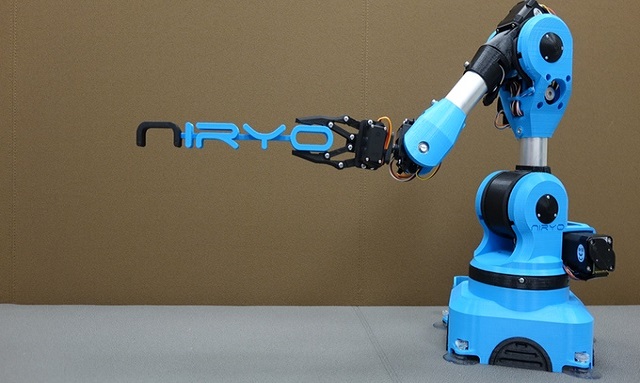


Industrial robots improve every year. They become more powerful and more precise. However, their price is still very high and they are only available for big industrial factories. If you want to get a robotic arm for your home, your school, or your small company, you will have to spend between 20,000 $ and 200,000 $, and most companies will not even bother selling a robot to you.
Meet Niryo One. Niryo One is an accessible 6 axis robotic arm.
Powered by Arduino, Raspberry Pi and ROS, it is made for makers, education, and small companies.

The robot is 3D printed and is capable of running STL files and code on the robot will be open source after the first shipments. The developers of Niryo One intend to build a complete set of cloud services around Niryo One, and a community around open source projects.
Having 6 axis, Niryo One can grab anything in its area, with any given orientation. With 6 axis, it can draw on a vertical board, or any non horizontal surface. In reality, the things one wants to pick with a robot are not always on a flat surface, and on the ground. This is a huge limitation, but not for Niryo One.
By being open source, the company also lets users to develop more use cases and functionalities
Making it work has also been made easy as it comes right out of a Kit box. Users can control the robotic arm with many interfaces and tools.
It predominantly has several modes for learning :
Learning mode : The robot can be moved around with our hands, it will then go to all saved positions (close loop control). A great way to teach the robot what to do, and when users don’t feel using a mobile or computer.
This mode will also allow students and children to use Niryo One, without knowing anything about robots or computers. They can learn some basic mechanical principles, and get to know more about how robots are working.
Joystick Controls: It allows users to Control Niryo One with a joystick (xbox or playstation controller). You can choose position mode (x,y,z, and orientation of the end effector tool), or joint mode (control each axis independently)
G-code (currently in development) : The Niryo One can also be directly controlled with a web (any browser) or mobile (android, iOS) application. Users can use it to replay some sequences, that have been saved with the “learning mode”.
Users can also create or modify and own movement sequence. By giving values to the robot (coordinates or joint angle), the robot will move to the target point. With wireless connectivity through WiFi, Niryo One will be connected to the home Wi-Fi network. This enables users to control it wirelessly from any part of the residence.

The structure of Niryo One is made out of 3D printed parts.
Thanks to the robustness of 3D printed parts, the robots can be improved without changing everything in the production line.
Here are all the parts included in Niryo One :
The robotic arms uses 5 steppers motors to move the 4th first axis, and 2 servomotors to move the 5th and 6th axis.

All axis are closed-loop controlled, using magnetic sensors for stepper motors, and analog input for servo motors. This is very useful for the learning mode, as the robot can be taught what to do, and it can position itself accordingly.

The control of the robot is via an Arduino Mega board with a RAMPS 1.4 shield to control and supply power to all the motors. There’s also a Raspberry Pi 3 board on board Niryo One. This is used to run ROS (Robot Operating system) to provide a simulation of the robot, advanced computations, and an interface to web and mobile applications. Moreover, the Raspberry Pi 3 board will allow Niryo One to be 100% autonomous.
Technical specifications :

Source: Kickstarter
